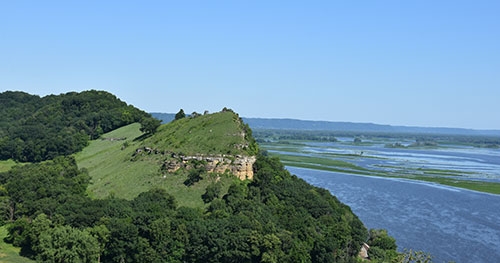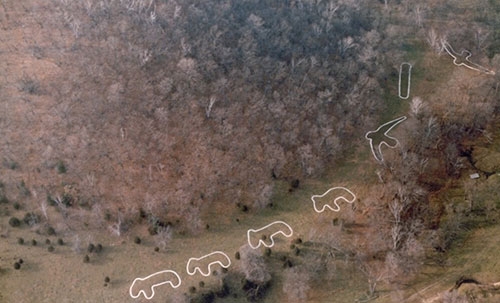You are here
Home ›Looking back, looking forward: Preservation of Buckmaster property helps protect some of Iowa’s rarest natural, archaeological treasures

Historic bluff and surrounding area permanently protected under conservation easement ... Capoli Bluff, located south of Lansing, is part of the Raleigh and Joey Buckmaster property permanently protected under a conservation easement through the Iowa Natural Heritage Foundation. The historic bluff offers views of two states, the Mississippi River, and surrounding woodland and prairie that has been restored by the Buckmaster family. Photo courtesy of Iowa Natural Heritage Foundation.

A view of historical and sacred significance ... The historic effigy mounds on the Raleigh and Joey Buckmaster property south of Lansing are best viewed from above to realize their full impact. Outlined in lime, the bear, bird and linear mounds are clearly visible from all perspectives. Photo by Luther College/Clark Mallam through the courtesy of Iowa Natural Heritage Foundation.

Raleigh and Joey Buckmaster. Submitted photo.

Indicator of high quality prairies ... For nearly 50 years, Raleigh and Joey Buckmaster of Lansing have carefully restored and preserved their property, protecting some of Iowa’s rarest natural and archaeological treasures. The results of that work are evident in the leadplant (Amorpha canescens pictured in the photo foreground above), which is an indicator of high quality prairies, that covers Capoli Bluff south of Lansing. Photo courtesy of Iowa Natural Heritage Foundation.
(Editor’s Note: The following article originated in a December 27, 2022 emailed newsletter from the Iowa Natural Heritage Foundation [INHF] and also appears in the Winter 2023 edition of “Iowa Natural Heritage” magazine. It is being reprinted here with permission secured through the Iowa Natural Heritage Foundation)
by Mack Swenson, Communications Intern
What do you see when you look out over a landscape? Structural features like rivers and hills, or perhaps you notice the wildlife and plants that call it home?
What about history? Can you see the impacts of this land’s early and recent inhabitants, or how geologic events have shaped its valleys and ridges?
On Capoli Bluff, you can. In fact, you can see a lot of things from Capoli. You can see the Mississippi River stretching off far beyond view, two states, an abundance of restored prairie and - if you know where and how to look - you’ll see huge effigy mounds in the shapes of bears and falcons that Native Americans constructed a thousand years ago.
This was sacred land for the generations of people who lived here long before European settlement. Raleigh and Joey Buckmaster, who live here now, feel the same way.
“My father was fond of saying, ‘live where you want to - the rest will take care of itself.’ That has turned out to be sage advice for our family. Living here has deepened our understanding and respect for this land and it’s offerings,” said Raleigh. “When we live with the natural world, we are absorbed and become one, as were the Mound Builders.”
Recognizing the significance of the property that’s been in the family for decades, the Buckmasters protected the riverfront bluffs under a conservation easement with INHF in 2004.Now, after observing accelerated development along the river, the couple feels compelled to place the remainder of the property’s sensitive natural areas under a second conservation easement, safeguarding an additional 365 acres and expanding their 40-year restorative vision to the bluff’s southwestern slopes and valley.
These aren’t just any bluffs. Capoli rises a startling 420 feet from the river’s banks and is one of two distinctive bluffs on the property. The family calls the other bluff “Bonsai,” as it features an iconic cedar tree wizened by the region’s prevailing winds. The two-mile stretch of protected bluffline on the Buckmaster’s property is particularly impressive when viewed from the air. Raleigh, a licensed pilot, enjoyed showing friends and visitors the property from this perspective, but he and Joey also saw encroaching development.
“From the air you can see that it’s just big home after big home after big home all across the ridges, especially on the Wisconsin side,” Joey said. “But then it started over here on the Minnesota and Iowa side. Then you’d fly over Capoli, and it’s really just a little oasis.” Despite numerous offers from developers, the couple refuses to sell their “little piece of heaven.”
Now, native wildflowers and grasses abound on Capoli Bluff’s back slope, but it wasn’t always this way. When the couple bought the property from Raleigh’s parents in 1976, a modest cattle operation and row crops had occupied portions of the property, and an unsuccessful attempt to create a pond left a massive dike in the valley. One of their first undertakings was to remove internal fencing and sell the cattle, who grazed the land bare. Removing the dike - a significant project - came later.
“I came up here at 11 years old, that was the first time I saw it and saw what it was, and I guess you could say at that point I knew I wanted to live here, raise a family here, and - if the right word is restore - live with the land, and see where it takes you,” Raleigh said. “Preservation is where it took us.”
These past 40 years, the couple has continued to take an active role in removing invasive woody species like cedar and sumac from the bluffs and conducting prescribed burns. INHF has assisted in these efforts through annual intern workdays, but the Buckmasters take the lead.
“Raleigh and Joey are so active in the stewardship of his property,” Senior Land Stewardship and Blufflands Director Brian Fankhauser said. “I think that it’s impressive when you see private landowners investing so much.”
European explorers noted Capoli in their journals for its distinctive shape and size. But for everything the bluff offers in terms of scenic beauty, it also provides invaluable habitat for wildlife - including nesting and migratory birds, peregrine falcons, bobcats and timber rattlesnakes - and features a range of vegetation rarely seen in Iowa.
“When you look at the scenic beauty, the diverse wildlife habitat, the rattlesnakes, the remoteness and the wildness that you feel when you’re in that place - you don’t get that sense in too many places in Iowa,” Fankhauser said.
As if the property’s natural bounty was not sufficient, it is also archaeologically rich. Colin Betts, an archaeologist and professor at Luther College, says it represents the second largest grouping of effigy mounds in Iowa, and the largest on private property.
“The mounds continue to be sacred for Native Americans, [but] building the mounds did not make this place a sacred landscape,” Betts said. “They built them here because it already was. In other words, they’re building the mounds here because they were hoping to tap into that power.”
Native Americans residing in the area saw the property’s springs and eagle nests as signs that the forces of the upper world and the lower world are stronger here. The mounds, therefore, represent the idea of movement - the journey that the soul makes to the afterlife - as well as a ritual of spring rebirth. These features generate a sense of spirituality regardless of one’s religious orientation.
The Buckmasters have welcomed many visitors to this property including close friends and guests. Almost everyone comes away with a sense of wonder.
“It is 100% a spiritual place, and if you’re here for very long - or even a short period of time, lots of people realize that and they feel it,” Joey said. “It’s so special that you don’t want it to go away and you don’t want it to ever be developed.”
Even now, after spending nearly a half century looking at the river framed by the bluffs through their living room window, the couple says they continue to be taken aback by its beauty. People ask them, “Do you ever get tired of this view?” Their answer is, of course, no - it changes every moment.
“It’s hard to explain to people because I would never consider living anywhere else,” Joey said.
Consistent with their reason for protecting the land, the Buckmasters view their restoration efforts as Raleigh and Joey Buckmaster “eliminating the encroachment of the modern world.” Raleigh and Joey describe three distinct ‘seasons’ of their usage of the property, the last of which is defined by efforts to remove negative human influence on the land and restore the prairie. They describe the land as a gift for family and friends, a place where visitors can imagine moving back in time.
The various influences of man and nature are apparent: 10,000 years ago, the movements of the Mississippi River carved these bluffs; 1,000 years ago, Native Americans honored this sacred space; 40 years ago, Raleigh and Joey started their restoration journey; and now, the remainder of this invaluable landscape is permanently protected.

